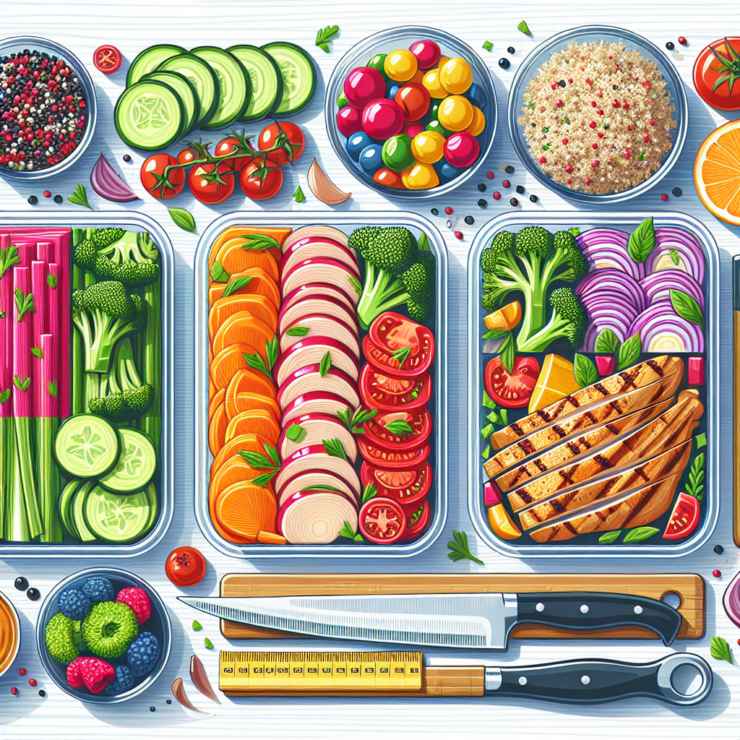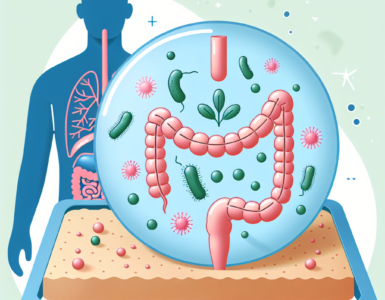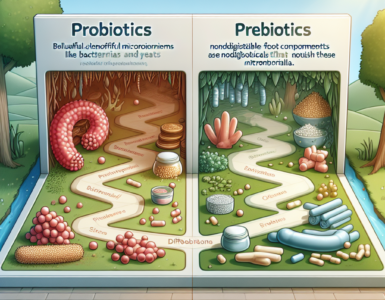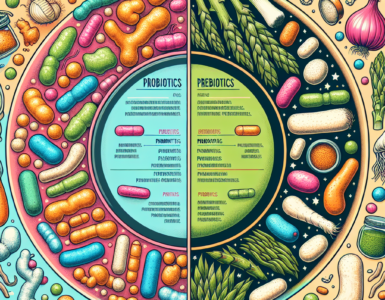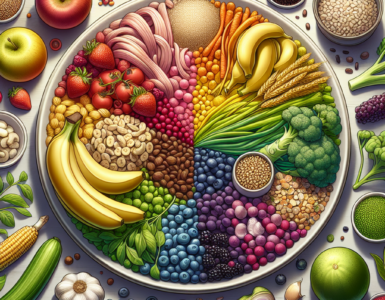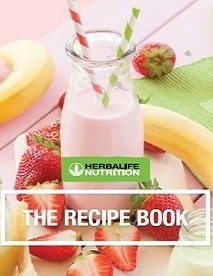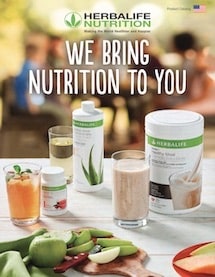Introduction to Low-Calorie Meal Prep
The Importance of Calorie Management in Weight Loss
When it comes to shedding pounds or maintaining a healthy weight, the principle of calorie management plays a pivotal role. Weight loss occurs when the body expends more calories than it takes in, creating what is known as a calorie deficit. By carefully crafting a meal plan that satisfies nutritional needs while staying within a lower calorie range, individuals can effectively manage their weight without resorting to drastic or unsustainable dieting tactics.
Understanding the balance between calorie intake and expenditure is essential for successful weight management. It is not merely about consuming fewer calories; it’s about ensuring that those calories come from nutrient-rich foods that can support overall health and satiety throughout the day. This strategic approach to eating not only aids in weight loss but also helps individuals develop habits that contribute to long-term health and wellness.
The Basics of Meal Prepping for Calorie Deficit
Meal prepping for a calorie deficit revolves around planning and preparing meals in advance. This practice is instrumental in controlling caloric intake and resisting the temptation of high-calorie foods that can derail weight management efforts. A well-prepped meal plan can help maintain a consistent eating pattern, reduce the likelihood of impulsive eating decisions, and ensure that each meal contributes to the overall nutritional goals.
To begin meal prepping for a calorie deficit, one must first understand the caloric content of various foods and how they fit into a daily meal plan. This involves calculating an individual’s daily calorie needs based on their specific goals, activity level, and metabolic rate. With this information, one can determine the appropriate portion sizes and ingredients that align with their low-calorie meal prep objectives.
| Meal | Average Caloric Content |
|---|---|
| Breakfast | 300-400 Calories |
| Lunch | 400-500 Calories |
| Dinner | 400-500 Calories |
| Snacks | 100-200 Calories |
The table above provides a general guideline for the caloric content of meals throughout the day. However, these numbers can vary based on individual requirements and meal preferences. The key is to distribute calories effectively across meals to ensure sustained energy levels and prevent hunger pangs that could lead to overeating.
Meal prepping also involves selecting a variety of foods that provide a balance of macronutrients—proteins, fats, and carbohydrates—while keeping an eye on their calorie content. This balance is crucial for meeting the body’s needs for essential nutrients while staying within a calorie deficit. By planning ahead and preparing meals in advance, individuals can take significant strides towards their weight management goals, enjoying delicious and satisfying low-calorie meals that support a healthy lifestyle.
Planning Your Low-Calorie Meal Prep
Embarking on a journey toward weight management often involves a strategic approach to eating, and that’s where low-calorie meal prep comes in. It’s not just about reducing calorie intake; it’s about making sure every calorie counts towards your nutritional needs.
Setting Caloric Goals
The first step in planning your low-calorie meal prep is to determine your daily caloric goals. These targets will vary based on individual factors such as age, gender, weight, height, and activity level. A common approach is to establish a calorie deficit, consuming fewer calories than your body expends, which typically leads to weight loss.
| Factors | Caloric Goal Range |
|---|---|
| Sedentary Female | 1,200 – 1,500 |
| Sedentary Male | 1,500 – 1,800 |
| Active Female | 1,400 – 1,700 |
| Active Male | 1,800 – 2,100 |
Balancing Macronutrients
It’s crucial to ensure that your low-calorie meals are not only sparse in calories but also rich in nutrients. Balancing macronutrients – proteins, fats, and carbohydrates – is key to satisfying hunger and providing energy throughout the day.
A balanced approach might look like the following distribution:
| Macronutrient | Percentage of Daily Calories |
|---|---|
| Protein | 20-30% |
| Fat | 25-35% |
| Carbohydrates | 45-55% |
Incorporating a variety of foods within these groups ensures you receive the full spectrum of nutrients your body needs.
Grocery Shopping for Low-Calorie Foods
When it comes to shopping for low-calorie foods, prioritize fresh produce, lean proteins, whole grains, and healthy fats. Here’s a starter list to help individuals prepare meals that are flavorful, nutritious, and aligned with weight management goals.
| Food Category | Examples |
|---|---|
| Fruits & Vegetables | Berries, leafy greens, bell peppers |
| Lean Proteins | Chicken breast, turkey, tofu |
| Whole Grains | Quinoa, brown rice, whole wheat pasta |
| Healthy Fats | Avocado, nuts, olive oil |
| Dairy | Greek yogurt, cottage cheese |
By focusing on these staples, you can create a versatile and satisfying meal plan tailored to a low-calorie diet. Keep in mind that the quality of the calories is just as important as the quantity when it comes to healthy eating and weight management.
Low-Calorie Breakfast Ideas
Crafting a breakfast that’s both nourishing and low in calories is essential for those managing their weight. Breakfast sets the tone for the day, and with the right ingredients, one can create a meal that supports a calorie deficit without sacrificing satisfaction or flavor.
Protein-Packed Starters
Protein is a cornerstone of a filling, low-calorie breakfast, as it can help keep hunger at bay throughout the morning. Here are some high-protein, low-calorie breakfast ideas:
- Greek yogurt with a handful of berries
- Cottage cheese topped with sliced pineapple
- A smoothie made with spinach, protein powder, and almond milk
| Meal Idea | Calories | Protein (g) |
|---|---|---|
| Greek Yogurt & Berries | 150 | 20 |
| Cottage Cheese & Pineapple | 180 | 28 |
| Spinach & Protein Smoothie | 220 | 25 |
Low-Calorie Smoothies and Bowls
Smoothies and bowls can be a quick, easy, and low-calorie way to start the day, especially when focusing on fruits, vegetables, and lean protein sources. Here are a few combinations:
- Berry smoothie with non-fat milk and a scoop of protein powder
- Acai bowl with mixed berries and a sprinkle of chia seeds
- Green smoothie with kale, apple, cucumber, and whey protein
| Smoothie/Bowl | Calories | Protein (g) |
|---|---|---|
| Berry Protein Smoothie | 200 | 26 |
| Acai Berry Bowl | 250 | 4 |
| Green Kale Smoothie | 180 | 20 |
Egg-ceptional Meals
Eggs are a versatile and protein-rich option for a low-calorie breakfast. They can be prepared in a variety of ways to suit any taste:
- Scrambled eggs with spinach and tomatoes
- An omelet filled with mushrooms, peppers, and onions
- Hard-boiled eggs alongside a small serving of avocado
| Egg Meal | Calories | Protein (g) |
|---|---|---|
| Scrambled Eggs & Veggies | 200 | 14 |
| Veggie Omelet | 250 | 18 |
| Boiled Eggs & Avocado | 300 | 15 |
These breakfast ideas are not only low in calories but packed with protein to help maintain muscle mass and promote satiety. By starting the day with these nutritious meals, individuals can stay on track with their low-calorie meal prep and weight management goals.
Low-Calorie Lunch Ideas
Lunch is a critical meal in the day, especially for those managing their weight through a careful diet. Low-calorie meal prep for this midday meal focuses on combining nutrient-rich foods that are low in calories but high in satisfaction to keep energy levels stable throughout the afternoon.
Salads that Satisfy
Salads are a quintessential part of a low-calorie diet, but they need not be dull or unappetizing. Satisfying salads combine a variety of textures and flavors, along with a balance of protein, fiber, and healthy fats to create a fulfilling meal.
| Ingredients | Calories (approx.) |
|---|---|
| Mixed greens (2 cups) | 20 |
| Cherry tomatoes (1/2 cup) | 15 |
| Cucumber (1/2 cup) | 8 |
| Grilled chicken breast (3 oz) | 128 |
| Avocado (1/4) | 80 |
| Balsamic vinegar (1 tbsp) | 14 |
Mixing leafy greens with colorful vegetables, lean proteins like grilled chicken or tofu, and a slice of avocado can create a flavorful and nutritious salad. Dressings should be used sparingly, with an emphasis on vinegar or citrus-based options to keep the calorie count in check.
Light Wraps and Sandwiches
Wraps and sandwiches are convenient options for lunch, and they can be made low-calorie with the right ingredients. Using whole grain or low-calorie tortillas and bread, one can layer in lean meats, a variety of vegetables, and a spread like hummus or mustard for a filling and low-calorie meal.
| Ingredients | Calories (approx.) |
|---|---|
| Whole grain tortilla | 100 |
| Turkey breast slices (3 oz) | 90 |
| Spinach (1/2 cup) | 3 |
| Bell peppers (1/2 cup) | 12 |
| Hummus (1 tbsp) | 35 |
When prepping these meals, it’s essential to consider the fillings carefully to maintain a low calorie count. Opting for fresh vegetables and lean protein sources can yield a delicious and nutritious lunch that fits within a calorie-deficit diet.
Homemade Soups
Homemade soups can be a warm and comforting lunch option that is also low in calories. By controlling the ingredients, one can ensure that the soups are filled with nutrients without the excess sodium often found in store-bought varieties.
| Ingredients | Calories (approx.) |
|---|---|
| Vegetable broth (1 cup) | 15 |
| Chopped carrots (1/2 cup) | 25 |
| Chopped celery (1/2 cup) | 10 |
| Diced chicken breast (3 oz) | 128 |
| Brown rice (1/4 cup) | 54 |
Creating a soup with a base of vegetable broth, lean proteins like chicken or beans, and an assortment of vegetables can provide a satisfying and hearty meal. Whole grains like brown rice or quinoa can be added in moderation to enhance the soup’s texture and provide additional fiber.
For those engaged in low-calorie meal prep, lunchtime represents an opportunity to enjoy a delicious, nutritious meal that supports their weight management goals. The focus should be on fresh, whole ingredients prepared in ways that preserve their natural flavors and nutritional value while keeping calorie counts low.
Low-Calorie Dinner Ideas
Creating a satisfying dinner while managing calorie intake is a crucial aspect of weight management. These low-calorie dinner ideas focus on incorporating lean proteins, an abundance of vegetables, and cooking methods that retain flavor without adding unnecessary calories.
Lean Protein Dishes
Lean proteins are the cornerstone of a low-calorie dinner, as they provide essential nutrients without an excess of calories. Poultry, fish, tofu, and legumes are excellent sources of lean protein that can be prepared in a variety of ways to keep dinners interesting.
| Protein Source | Serving Size | Calories |
|---|---|---|
| Grilled Chicken Breast | 3 oz | 128 |
| Baked Cod | 3 oz | 89 |
| Tofu (Firm) | 1/2 cup | 94 |
| Lentils (Cooked) | 1/2 cup | 115 |
Veggie-Forward Entrees
Vegetables are low in calories but high in fiber and nutrients, making them a perfect base for dinner meals. One can create a plethora of entrees by spiralizing zucchini into noodles or using cauliflower as a rice substitute. The possibilities are endless, and the calorie count remains low.
| Vegetable | Serving Size | Calories |
|---|---|---|
| Zucchini Noodles | 1 cup | 20 |
| Cauliflower Rice | 1 cup | 25 |
| Steamed Broccoli | 1 cup | 55 |
| Roasted Brussels Sprouts | 1 cup | 38 |
Stir-Fries and Skillets
Stir-fries and skillets allow for a mix of lean proteins and vegetables with intense flavors, without adding many calories. Using cooking sprays, broth, or water to sauté instead of oils can significantly reduce the calorie content.
| Ingredients | Serving Size | Calories |
|---|---|---|
| Chicken and Vegetable Stir-Fry | 1 cup | 150-200 |
| Shrimp and Asparagus Skillet | 1 cup | 120-170 |
| Tofu and Mixed Pepper Stir-Fry | 1 cup | 100-150 |
| Beef and Broccoli Skillet | 1 cup | 160-210 |
By incorporating these low-calorie meal prep ideas into your dinner routine, you can enjoy delicious and nutritious meals that support your weight management goals. Remember to always measure ingredients and be mindful of portion sizes to stay within your caloric goals.
Snacks and Desserts
Snacking and desserts often present the largest challenge when one is managing their caloric intake. However, with the right choices, these can be included in a low-calorie meal prep plan that satisfies cravings without compromising weight management goals.
Healthy Snacking Options
Healthy snacks are essential in keeping hunger at bay between meals and providing an energy boost. They should be nutrient-dense, offering a good balance of protein, fiber, and healthy fats, while still being low in calories.
| Snack Option | Calories (Approx.) | Protein (g) | Fiber (g) |
|---|---|---|---|
| Sliced vegetables with hummus | 150 | 6 | 6 |
| Greek yogurt with berries | 120 | 12 | 3 |
| Almonds (1 oz) | 170 | 6 | 3 |
| Air-popped popcorn (3 cups) | 90 | 3 | 4 |
| Apple slices with peanut butter (1 tbsp) | 150 | 3 | 4 |
These snacks are not only fulfilling but also contribute to the nutritional value of your daily meal plan. It is important to measure portions to ensure calorie intake remains within your target range.
Low-Calorie Sweet Treats
For those with a sweet tooth, finding low-calorie desserts can be a delight. These treats should satisfy the craving for something sweet without adding too many calories to your daily total.
| Dessert Option | Calories (Approx.) | Sugar (g) | Fat (g) |
|---|---|---|---|
| Mixed berry salad | 80 | 10 | 0 |
| Jello with whipped topping | 100 | 18 | 2 |
| Frozen yogurt bark | 140 | 12 | 4 |
| Baked apple with cinnamon | 95 | 19 | 0 |
| Dark chocolate (1 square) | 50 | 4 | 3 |
These dessert options offer a hint of sweetness and are perfect for rounding out a meal or as a standalone treat. Remember to enjoy these in moderation and be mindful of portion sizes.
Incorporating these snacks and desserts into your meal prep routine can help you maintain a calorie deficit while still enjoying a variety of tasty options. By planning ahead and preparing these low-calorie choices, you can fend off hunger and stay on track with your weight management objectives.
Tips for Successful Low-Calorie Meal Prep
Creating low-calorie meals that are both nutritious and full of flavor requires careful planning and smart strategies. These tips will help you maintain excitement in your meals, manage portions effectively, and save time during meal preparation.
Keeping Flavors Fresh
One of the challenges of low-calorie meal prep is keeping meals interesting and flavorful without adding extra calories. Here are ways to achieve that:
- Use a variety of herbs and spices: They add depth and complexity to your meals without contributing significant calories.
- Incorporate acidic components: A squeeze of lemon juice or a dash of vinegar can brighten up dishes and enhance natural flavors.
- Be creative with cooking methods: Techniques like roasting, grilling, or steaming can bring out different flavors and textures in your ingredients.
Portion Control
Managing portion sizes is critical when preparing low-calorie meals. It ensures that you are consuming the right amount of calories for your weight management goals. Here’s how to stay on track:
- Measure ingredients: Use measuring cups and food scales to keep portion sizes accurate and consistent.
- Learn visual cues: Familiarize yourself with the visual equivalents of standard portion sizes, such as a serving of protein being about the size of a deck of cards.
- Pre-package meals: Separate meals into individual containers to avoid the temptation of overeating.
Time-Saving Strategies
Efficient meal prep can save you time and reduce the stress of cooking every day. Below are strategies to streamline your meal prep process:
- Batch cook: Prepare large quantities of staple ingredients, like grains and proteins, to use throughout the week.
- Embrace one-pan meals: Dishes that can be cooked on a single sheet pan or in one pot minimize cleanup time.
- Plan ahead: Set aside a specific time for meal prep and stick to your schedule to avoid last-minute decisions and potential unhealthy choices.
By focusing on these key strategies, individuals can create a sustainable and enjoyable low-calorie meal prep routine. Flavorful meals, correct portion sizes, and efficient prep methods contribute to successful weight management and a satisfying dietary experience.
Health and Nutrition Disclaimer: Please note that the recipes and advice provided are for general information purposes only and should not be considered as medical or professional health advice. Always consult with a healthcare professional or a dietitian before starting any new diet or making significant changes to your eating habits, especially if you have health concerns or conditions.


